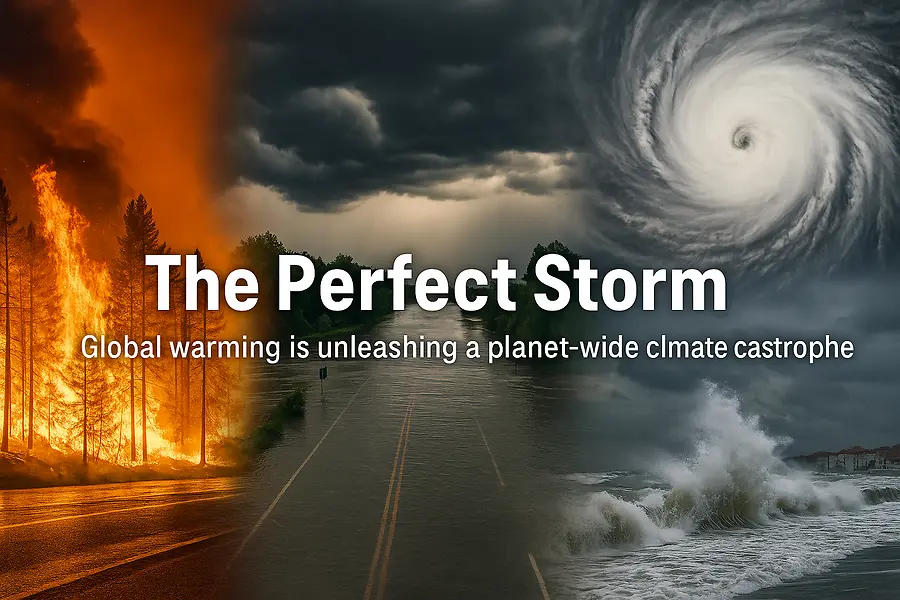The Perfect Storm
Global Warming Is Unleashing a Planet-Wide Climate Catastrophe

Global warming is no longer a distant theory whispered in laboratories—it’s the present-day reality reshaping life on Earth. We are witnessing, in real time, a perfect storm of environmental upheaval. Fueled by human-caused climate change, weather extremes are escalating in frequency, intensity, and cost—redefining what we once considered "natural disasters."
From wildfires that reduce communities to ash to hurricanes that rewrite meteorological records, climate change is generating a cascade of destruction that reverberates across every continent.
Climate Disasters Are Increasing—And We’re the Catalyst
In the first half of 2025 alone, natural disasters inflicted over $131 billion in losses globally, with climate change acting as an accelerant in nearly every case. A staggering 88% of these losses were weather-related, and when you factor in cascading effects—such as displaced populations, ecological collapse, and economic disruption—those numbers balloon to $2.3 trillion annually.
This isn’t just a fiscal crisis. It’s a human one. Extreme weather now kills millions annually, displacing communities and threatening the social fabric of vulnerable regions. For environmentalists, policymakers, and energy experts alike, this is the inflection point.
Heat: The Engine of Climate Chaos
Heatwaves—No Longer Unusual, Just Unrelenting
Heatwaves are now regular events, with temperatures climbing into ranges that challenge human survival. During the summer of 2025, a massive heat dome settled over the U.S., exposing over 255 million Americans to dangerous conditions.
Why is this happening? The physics is clear: more greenhouse gases mean more trapped heat. As global temperatures rise, extreme heat events multiply—nonlinearly. At a 2°C increase, we’ll see double the intensity of heat extremes compared to a 1.5°C increase. At 3°C, it quadruples.
The consequences are deadly—and irreversible without immediate intervention.
Drought: The Silent Catalyst
The American West is now locked in a megadrought, one of the worst in 1200 years. As temperatures climb, the atmosphere becomes thirstier, pulling moisture from soils, plants, and waterways. This isn't just inconvenient; it's catastrophic.
Dry vegetation becomes tinder. Rivers shrink. Agriculture suffers. And all of it feeds into a vicious cycle of water scarcity, food insecurity, and regional instability.
Fire and Fury: When Heat Meets Drought
The fusion of high heat and persistent drought gives us something terrifying: wildfire seasons that know no season at all.
In 2025, winter wildfires ravaged Los Angeles—$53 billion in damages, the costliest wildfire event in recorded history. These weren't summer anomalies; they were winter infernos, burning in what used to be California’s rainy season. Climate change has erased those seasonal boundaries.
Forests become fuel. Drought dries out the land. All it takes is a spark.
Storms Supercharged by Warming Oceans
Hurricanes are evolving into monsters. The Atlantic is warmer. Storms are stronger, faster-forming, and slower to weaken. Their tracks are shifting northward, and their danger zones are expanding.
Hurricane Beryl, the earliest Category 5 storm on record (2024), fed off record-high sea surface temperatures. As waters warm, the storms don’t just grow—they explode in strength, leaving less time to prepare.
Increased water vapor means storms dump more rain, cause more flooding, and batter communities with triple threats: wind, water, and surge.
Sea Level Rise: The Waters Are Already at Our Doorstep
Rising seas are not projections—they’re measurable. In some U.S. coastal areas, high-tide flooding has increased by up to 900% over the past five decades. The culprit? Melting polar ice and thermal expansion of ocean waters.
Between 1992 and 2016, Greenland’s ice loss jumped from 34 to 247 billion tons per year. In Antarctica, it quadrupled.
By 2100, 200 million people could be living below the high-tide line. And it won’t take a hurricane to flood them out—a sunny day will do.
The Precipitation Paradox: Flood and Drought in the Same Region
Climate change doesn’t play fair—it gives with one hand and takes with the other.
Warmer air holds 7% more moisture per degree Celsius, making precipitation more extreme. In Texas, a July 2025 storm dropped the equivalent of Niagara Falls' daily volume in a matter of hours. Over 130 people died in the flash flood it caused. These sudden downpours arrive after long dry spells, overwhelming infrastructure and triggering deadly flash floods.
It’s not just more rain. It’s the wrong kind of rain, at the wrong time, in the wrong places.
Winter’s New Identity: Less Frequent, More Extreme
Global warming doesn’t mean no more winter—it means more volatile ones. As the Arctic warms, the polar vortex destabilizes, spilling frigid air into lower latitudes.
Winter storms—while rarer—are packing more punch. Increased moisture capacity in the atmosphere leads to more snow, more ice, and more damage when cold snaps hit.
The result? A paradox: shorter winters but deadlier winter weather.
Landslides, Erosion, and Coastal Collapse
Climate change destabilizes everything—including the ground beneath our feet.
Heavy rains saturate hillsides, triggering landslides even in traditionally low-risk areas. In drought-stricken landscapes, the lack of vegetation exacerbates erosion once the rains do return.
Rising seas and stronger storms are also accelerating coastal erosion. In the U.S. alone, it costs $500 million annually—a figure that will soar under projected climate scenarios.
The Dust is Rising—Literally
Worsening droughts and land degradation are stirring up more dust storms worldwide. Desert dust has risen 55% since the 1800s, and it's no longer just a visibility problem—7 million premature deaths per year are now linked to airborne particulates.
The UN has declared 2025–2034 the decade of dust storm mitigation. But climate change is making the task harder.
In Iraq, 300 dust storms per year may soon become the norm.
Tornadoes: A Shifting Threat
Tornadoes defy easy classification. Surprisingly, violent tornadoes have decreased by 50% since the mid-20th century. But outbreaks—clusters of 30+ tornadoes in one day—are on the rise.
"Tornado Alley" is shifting eastward, toward more densely populated, hurricane-prone regions. That change brings new risks to unprepared communities.
The Climate Web: Everything Is Connected
Droughts feed wildfires. Wildfires worsen landslides. Sea level rise amplifies storm surges. Changing rain patterns stress our crops and flood our cities.
Each climate event is no longer isolated—it’s part of a cascading, interconnected system reshaping our planet in real time.
According to attribution studies, 74% of extreme weather events are now directly tied to climate change. And as we warm past 1.5°C, the odds of more complex, compounding disasters increase exponentially.
We Are in the Perfect Storm—Now What?
We are not powerless—but we are out of time.
Without rapid, large-scale reductions in greenhouse gas emissions, the trajectory leads to 2°C, 3°C, or even 4°C of warming, where current disasters will seem tame by comparison.
In the face of such planetary upheaval, many ask: what can we actually do? The answer begins with a reexamination of our energy choices—and why nuclear power, long dismissed or misunderstood, may be the very tool that can help us steady the ship.
This is a call to action:
· If you’re a policymaker, this is your mandate.
· If you’re an environmentalist, this is your evidence.
· If you're an educator or investor, this is your curriculum and your portfolio.
· And if you're a general reader who cares about the planet, this is your moment to engage.
The storm is here. What we do now determines how we weather it.
(Please contact the author for a list of references for this article.)


